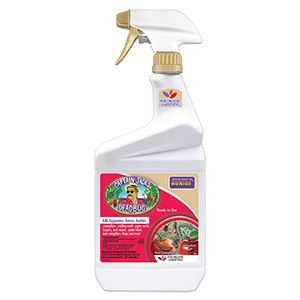European Corn Borer

How To Control the European Corn Borer
The European Corn Borer (Ostrinia nubilalis) is a widespread pest (found on three continents) known to feed on 250 different kinds of plants, some of which include: corn, pepper, chrysanthemum, dahlia, beet, bean, potato, tomato, cotton and soybean along with many kinds of weeds. Adults are small, tan, nocturnal moths. Females have a thick body and lighter colored wings than the males, which tend to be a darker tan-to-brown color.
Life Cycle & Appearance:
Adult moths typically start appearing in early spring to mate and lay eggs on desirable plants. The egg clusters can be found on the undersides of leaves and other sheltered areas that protect them from predators and harsh weather. There can be anywhere from one to four generations in a given season depending on local climate conditions and adaptation to those conditions. Once hatched, European Corn Borer larvae appear light brown to light pink in color with a brown head and dark spots on each body segment. Larvae prefer to feed on the whorl, but eventually move down into the stalk and ear as they continue to feed and grow for about 50 days. Once the larvae finish their sixth instar stage, they will pupate for a period of about 12 days.
Damage Symptoms:
The larvae eat leaves and tunnel in all parts of the stalks and ears with much of the major damage done to sweet corn found in the ears. The tunneling impairs the growth of the plant and diminishes yields of crop production. Early damage is typically found on tassels, whorl and leaf sheaths, but the larvae of European Corn Borers will also feed on silk, kernels, cobs and the stalk. Older larvae leave larger tunnels and their feeding habits are considered to be most damaging. European Corn Borer damage provides a pathway for fungal and bacterial diseases to become established.
Controlling European Corn Borers: Combining multiple control measures has proven to be the most effective way to control European corn borers. Single treatment approaches have shown mixed results.
- Use pheromone lures with wing traps to attract male corn borers and prevent mating before it occurs. Use lures & traps as monitoring tools to estimate pest populations and choose other treatments. Traps should be placed before first flight. Read our blog about how to properly monitor for corn borers!
- Release Trichogramma moth egg parasites once flight is detected.
- Btk (Bacillus thuringiensis kurstaki) sprays should be applied to ears, tassels, and whorls, but can also be applied to foliage throughout the growing season. Spinosad sprays work well also; however, they pose more risk to pollinators and other beneficials.
- Destroy stalks after the season and mow close to the surface. The stalks are overwintering sites for the larvae and this practice has proven to eliminate up to 75% of the larvae present. Do not compost infested or diseased plant material.
- Plant resistant varieties if possible.
-
$6.75–$11.99
-
$9.99–$29.99
-
$10.97–$41.48
-
$79.99–$170.00
-
$750.00–$2,700.00
-
$24.75–$119.50
-
$22.95
-
$13.49–$81.99
-
$14.49–$25.49
-
$15.99–$124.49
-
-
$13.95–$24.75
-
$6.50–$40.00
-
$16.65–$225.00
-
$16.65–$225.00
-
$19.99–$1,297.00
-
$46.99–$329.99
-
$270.00
-
$29.99–$72.50
-
$50.00–$562.50






















